


(Isabegović, the Turkish Isabegzade)
Isabegović is an Ottoman branch of an old Bosnian aristocratic family from the Kosača tribe.[1] The family founder was Ottoman governor and soldier Ishak beg Hranić in the 14th century but the family name is named after his son Isa-beg Ishaković Hranić and it is Isabegović. So, after him, all members of family Isabegović in their surname carry his name of Isa (Isa mean Jesus). Hıstorıan Jorga classifies Ishak as part of "Bosnian Turks" (die bosnischen Türken)[2].
Although it is not known exactly how Ishak-beg arrived in the city of Edirne, which at the time was the capital of the Ottoman Empire, he was likely sent as a pledge of loyalty to the Sultan. He is adopted[3] by the Jigit-bey in the court and thus enters the famous Turahanaoglu family which was one of the four families that led the Akıncı corps in the Ottoman Empire between the 15th-16th centuries and which were of Anatolian Christian origin known as Yörüks.
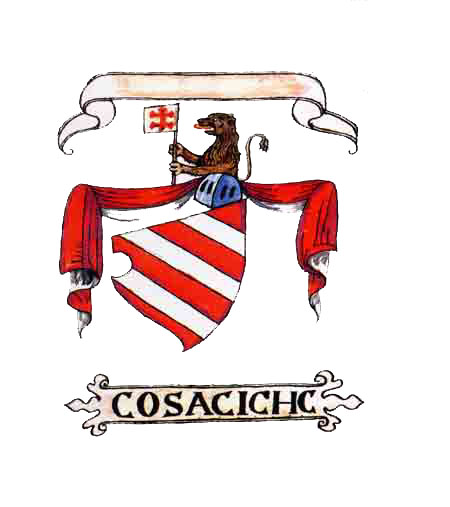 Arm of Coat On August 16, 1452, in a document relating to Isa-beg's visit, the people of Dubrovnik recorded for the first time his full name with the patronymic, together with his father's (Ishak) and his grandfather's (Hrana) name: Isabech Isachovich Cranusich.[4] In two Osman documents, his father Ishak-bey is referred to as "Ishak-bey ibn Koç"[5] and It is also referred to in some documents as "Ishak-bey Kosaç".[6] In a letter dated 01.02.1455. through the form of the stylization framework, Isa-bey Ishakovic publicly states that he is Herceg's brother and that Duke Petar Pavlovic is his relative.[7] That's uncovering that family roots are out from Hrana and his Kosača tribe.
Arm of Coat On August 16, 1452, in a document relating to Isa-beg's visit, the people of Dubrovnik recorded for the first time his full name with the patronymic, together with his father's (Ishak) and his grandfather's (Hrana) name: Isabech Isachovich Cranusich.[4] In two Osman documents, his father Ishak-bey is referred to as "Ishak-bey ibn Koç"[5] and It is also referred to in some documents as "Ishak-bey Kosaç".[6] In a letter dated 01.02.1455. through the form of the stylization framework, Isa-bey Ishakovic publicly states that he is Herceg's brother and that Duke Petar Pavlovic is his relative.[7] That's uncovering that family roots are out from Hrana and his Kosača tribe.
 Ishak-beg Hranic tombIt is not documented that the ancestors of the Isabegzade family practiced any religion before the family founder of Ishak-bey Hranić converted to Islam.
Ishak-beg Hranic tombIt is not documented that the ancestors of the Isabegzade family practiced any religion before the family founder of Ishak-bey Hranić converted to Islam.
They lived in the surroundings of the Bosnian Church, the Catholic Church, the Orthodox Church, Islam and Judaism. It is only documented that they supported the Bosnian Church.
They married women of different confessions. Thus, through the ancestors along the female line, we have the presence of the Christian Comneno line, although Siebmacher states that the root of the Kosače tribe to which the Isabegzade belongs, along with male origin are also of Comneno and Flavius.[18]
I2a1 haplogroup
The Isabegovic family belongs to haplogroup I2a1, namely I2a1b3-L621. According to this finding, it is assumed that family members originated in present-day Europe during the Late Paleolithic period (26,000 to 19,000 years ago). So, the firstborn of the family was born somewhere on the slopes of Dinara in the Paleolithic periods. Because of the migration that has taken place in the meantime, family blood relatives become constituent members of many nations that are forming in the territory of Europe and Minor Asia.

Haplogroup prevalence map by genetic markers for Isabegovic family members[15]
The prevalence of the family in terms of an absolute match by ethnic-racial to the Y-DNA haplogroup is homogeneous. The coverage area is limited by:
- in the north by Denmark, Germany, Poland
- in the south by the peninsula of Asia Minor and extends along the Mediterranean to Israel
- in the east by the territory of Ukraine
- on the west by the line Italy, France, British Isles
In addition to the homogeneous entity indicated, there are two enclaves; one of them in Russia and another one in the USA
Who are the "I2a" people?
Although it is believed that the haplogroup "I2a" was the haplogroup of the first anatomically modern humans to inhabit Europe, Cro-Magnon, we do not yet have a unique common name for all "I2a" humans. However, "I2a1 people" still represent a separate, distinct ethnic-racial group, and have always been and will be "I2a1 people," regardless of the subclade or nation to which they belong to, the passage of time, the migrations of their ancestors, the place where they live or the language they speak! Nations are a mix of different haplogroups, but the haplogroups themselves cannot be mixed! All family members are and will be I2a1b3-L621
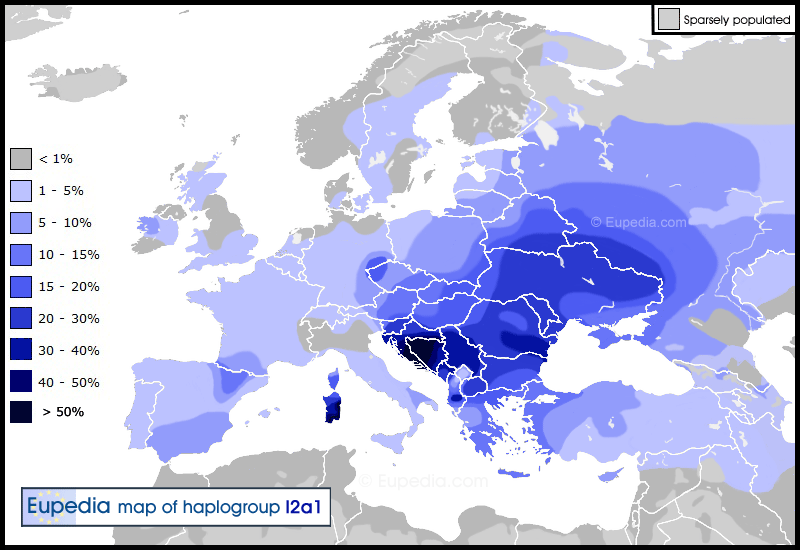 Haplogroup Map I2a1 [16]
Haplogroup Map I2a1 [16]
The "Disles" phenomenon
Within I2a1, the family belongs to a very rare group called "Disles". Nickname "Disles" was created because branch is related to the very common Dinaric group but it is found very often in the British Isles while the Dinaric group is usually in Eastern and Central Europe. (Disles= D for Dinaric + isles for British Isles). [17]
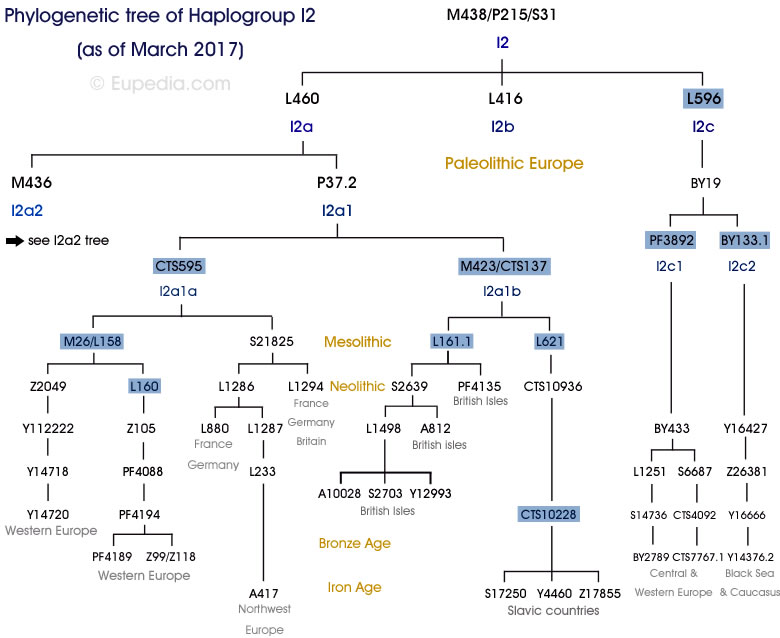
Phylogenetic tree [16] - Full Y-DNA path: I2a1b3-L621-C1S10936-C1S10228-S17250(PH908)
The family name is a credible monument of the material and spiritual culture of both the people and the person who created it and who preserves it as an expression of uninterrupted memory. As the family name is linked to the feudal order at the moment when the family is organized as a blood and production unit included in the privileged or the oppressed, since the birth charts of births, weddings and deaths began to be kept from the Council of Triden (1545-1563) in which surnames were entered for all social classes, it can be concluded that in the countries under the Ottoman Empire at the beginning of the 16th century the surname became permanent at one point, invariable and hereditary. The name Isabegzade, Isabegović, Isajbegović was also created at that moment by a patronym carried by the sons of Isa-beg Ishaković: Mehmed-beg, Ali-beg, Muhamed-beg, Husein-beg and Hasan-beg Isabegović. After them, all generations of their descendants have the same last name. Thus, it can be established that the surname belongs to the group of surnames expressing blood kinship, ie descendence through the parent-child relationship. Along with the last name they are proud of, family members cherish the oral tradition of belonging to the Kosača tribe and thus cherished the heritage, reputation and property.
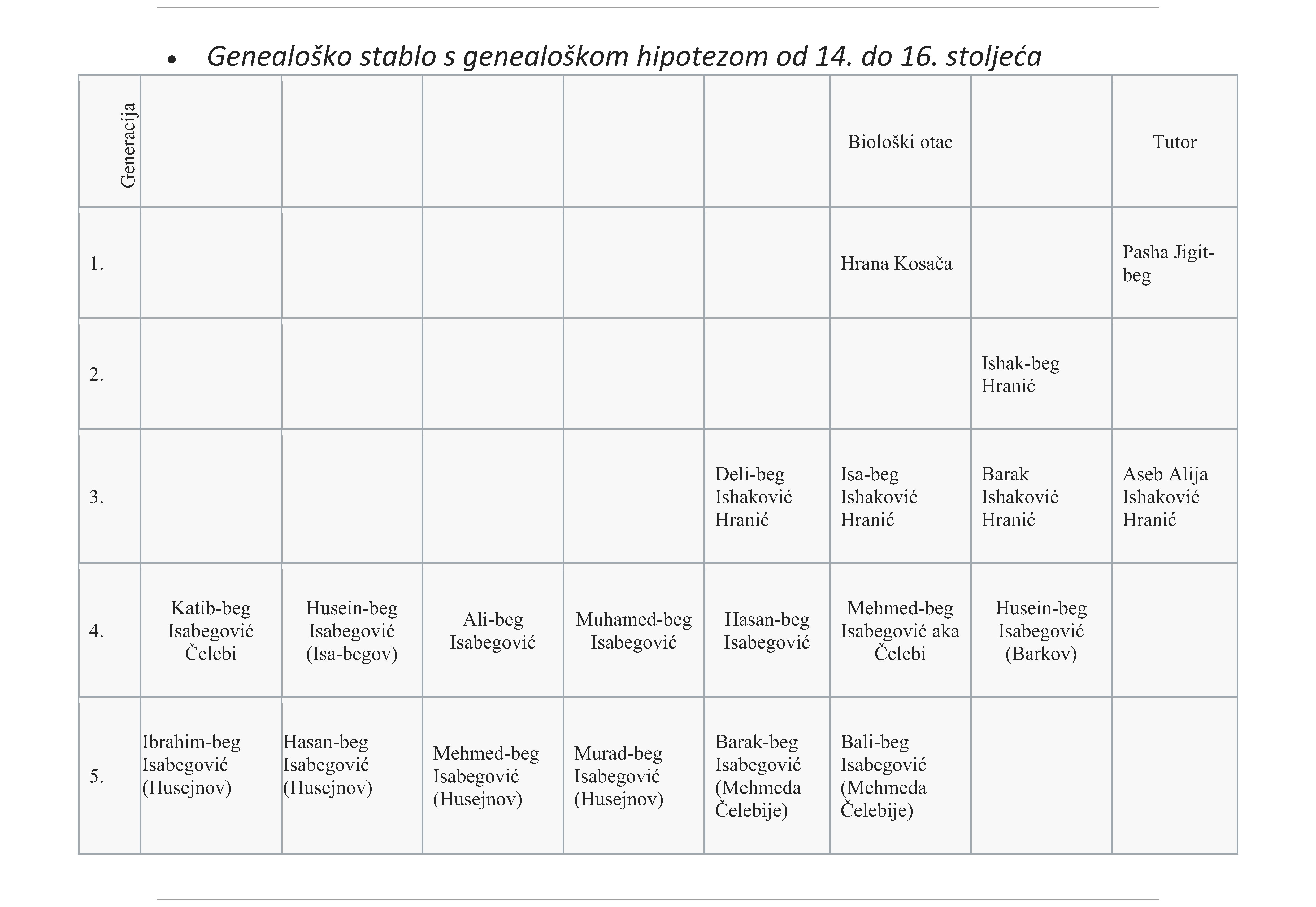
Some documents state that the name of the family founded by Ishak beg is Ishakovići. That's wrong. Ishak was the founder of the family and the first generation by patronym after him, is called Ishakovići. In this period of founding the family was not yet known for marking families by surname, but it happens over time both in Europe and in the Ottoman Empire in the next generation, which at that moment bears the patronym of the strongest representative of that moment - Isa beg, and from then everyone will be Isabegovic . The turning point in Europe was the Council of Trent 1545-1563, after which the recording of the surname for all feudal classes began. In parallel during this period we have Ali Beg Isabegovic, Mehmed Beg Isabegovic aka Celebi, Muhamed Beg Isabegovic[13] and Hasan Beg Isabegovic, and then the first generations after them Barak Beg Isabegovic, Bali Beg Isabegovic and all other generations who will came later carry heritage a lasting memory in their surname Isabegovic on patronym from the time the surname was created. Family name Isabegović belongs to the family of surnames which were formed on the basis of blood connection designation and belonging to the father-son relationship.
The Slavized surname with patronized suffix "- ić" is in accordance with the time, place and manner of surname creation, unlike the archaic Turkish versions with the suffix "- zade" and "- oglu" which have not survived anywhere in practical use except form "Isabegzade", in a case when we want to cover all forms of surname or indicate that something applies to all forms of surname, or Isabeyzade in the territory of today Turkey. For the Isabeyzade family, we do not currently have Y-DNA confirmation that they are related to others with Bosnia roots. As a rule, when one wanted to emphasize the non-Slavic origin of the family then the writer would use this Turkish form of surname Isabegzade or Isabeyoglu, even though the Isabegovic family has neither Slavic or Turkish origin. The prefix "Hadži" (Haji, Haci) or abbreviated "h." was in use only in the 19th century but was quickly put out of practical use. "Hadži" indicated that the person has performed the "Hajj" or he was descended from the person who performed the Hajj.
The family name has five correct forms:
Isabegović - Slavic version - still in use
Isajbegović - Slavic version with letter "j" - still in use
Hadži-Isabegović - Slavic version with the prefix "Hadži" indicating that the person performed the Hajj or he was descended from the person which performed the Hajj - not in use
Isabegzade - Turkish version - not in use in personal documents - it indicating the role that something applies to all forms of surname after their founder Ishak Beg Hranić
Isabeyzade&Isabeyoglu - possible branch in today Turkey - still in use
The wrong forms of family names are: Ishaković, Isaković, Ishakbeyzade.
Ishakbeyoglu is a possible branch in the Turkish territory behind the sons of Ishak bey Hranić who settled there in the 15th century. Further DNA research will confirm or challenge the present findings and at the same time open up new ones knowledge. For DNA confirmed persons from Turkey, we do not know whether they settled in Asia Minor during the Ottoman Empire or whether they arrived there from Europe thousands of years before or are a mixture of both.
Members of the Isabegzade family played a leading role in the 15th and mid 16th centuries in the territory of Bosnia and Herzegovina and the Sanjak of Üsküp (Skopje). From Istambul, "Sublime Porte" limited influence and worked on diminished the power of local Bosnian nobility and the Isabegovic family in order to more easily control the area under their administration to prevent anyone from becoming too strong and out of control. Their century domination over the town of Skopje, were replaced by governors of "devşirme" origin[8]. During two main eras of administrative organization of Ottoman Empire final the consequences of such a policy was the depletion and disappearance of even entire family sub-branches so that the entry of the Austro-Hungarian Monarchy into these areas in its worthy aristocratic and landowners status Isabegzade were survived in two branches: Isabegović from Gornji Rahić behind Isa-beg Isabegovic (married Adila Hanuma Gazibegović) and Isabegovic branch from Rainci near Tuzla after Hasan-beg Isabegovic[9]. The size of their landholdings, the number and size of serf settlements and serfs number is indicated in the archives of the Habsburg Monarchy until the end of 1918. The policy of the Kingdom of Yugoslavia, through looting agrarian reform and other social pressures, openly destroyed both the Bosnian nobility and the Bosnian non-Orthodox population. By the end of WWII, the Communist Party of Yugoslavia had completely destroyed all Bosnian nobility by the time of the exhalation, and the Isabegović family was adjusting to the new social circumstances. Deprived of material possessions, the Isabegović family maintained pride and honor by passing a tradition about its origin on their to the new generations. The members of the Isabegovic family have been great benefactors (Waqif) since its inception and have donated their properties for the needs of society and the religious community. Much of the inherited property from the period of the Kingdom of Bosnia and extended during the Ottoman Empire was donated in accordance with the regulations of the new adopted faith of Islam. They hit the foundations of many cities, built infrastructures, streets, hamams, hotels, shelters, sacral objects, mills, hundreds of shopping malls, and generously donated it.
The biggest and most famous of them are Ishak-beg Hranić (14th&15th c.), Isa-beg Ishakovič Hranić (15th c.), Mehmed-beg Isabegović Čelebi (15th&16th c.) Hasan-beg Isabegovic (19th. c.) and Isa-beg Isabegović(19th c.). It was the custom to name children mostly after their grandfather or other ancestors so we have many family members with the same names.
The endogamy in Ottoman Bosnia was inherited from the medieval Kingdom of Bosnia nobility, and was most extensively implemented by members of noble "bey" families. In addition, the "Kufva" Institute was present, where noblemen must be married "an equal with an equal" ("akran" with "akran").
Although the beys families were considered to be the leading strata and avoided any interference with the lower social classes during marriages, and that resulted in some standalone class closure, the family Isabegovic is related with their marriages to other Bosnian aristocratic families so that today the descendants of the Isabegovic family carry the origin along of their mother's line with noble families: Šahinpašić, Gradaščević, Gazibegović, Sokolović, Ljubović, Sijerčić, Salihbegović, Ibrahimbegović...
Endogamy and "kufva" was the case until the Second World War, and it is interesting that the beys called all other Muslims than their class lineage - Balija. [19]
From a genetic point of view, the above as an extreme example of endogamy, like historically the continuation of the millennial inbreeding in limited gene pool didn’t just keep traits within a bloodline, it also kept power. This has strengthened the already well-established domestic haplogroup I2a.
Since the 15th century, most of the Bosnian nobility have embraced the new faith and become actively involved in the administrative system of the Ottoman Empire. The right of nobility and clergy in European feudal states is not founded as such in the Ottoman Empire because Islam does not recognize class or racial differences between people. This is why Muslim law does not define the rights and privileges enjoyed by representatives of the ruling class. The Ottoman nobility was exclusively a military nobility and the noble title belonged to representatives of the military order. Any person could enter the nobility if he proved to be of merit to the state.
Members of the Isabegzade family carry the name "beg" in their surname, which means "duke". Sometimes the title "beg" (duke) is emphasized and put after the name. Example: Isa-beg, Ali-beg, Mehmed-beg, Idris-beg ...
The title "vojvoda" (duke) was inherited from the pre-Ottoman times of medieval Bosnia, so until the 16th century the titles "vojvoda" and "beg" were often put together in same documents. Example: "vojvoda Ali-beg Isabegovic"
The title "Gazi" means "warrior" and / or "winner" and is usually placed in front of the name. "Gazi" is an honorary title and designates a military commander. Example: Gazi Ishak-bey, Gazi Isa-bey, Gazi Mehmed-bey ...
Some of them carry special title "sanjak-bey". Example: Sanjak-bey Gazi Isa-bey Ishaković Hranić
The noble title "beg" (duke) have three variations: "beg", "bey" and "beigh" and they are hereditary.
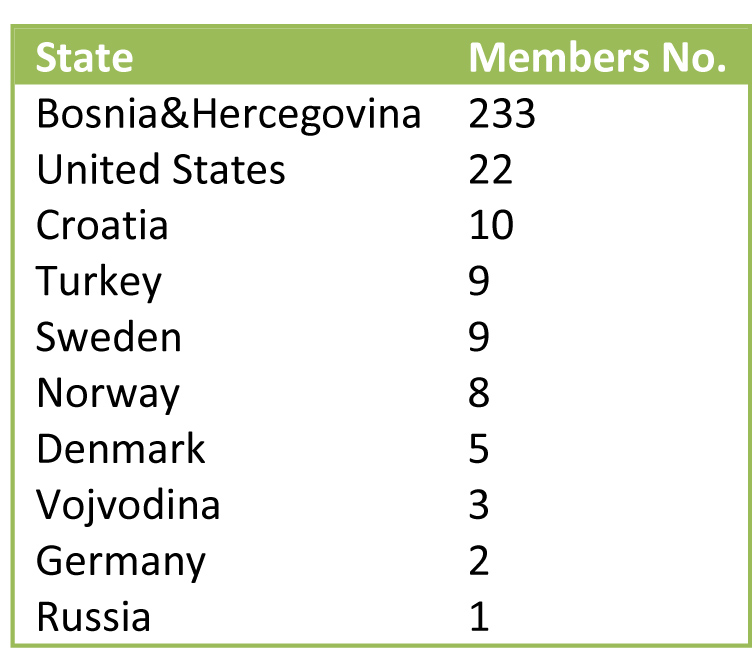 Base on records from 2014.Today, members of the Isabegzade family inhabit Bosna and Herzegovina, Croatia, the EU, Vojvodina, USA, and Turkey. There are indications that they exist in Serbia after WWII and Montenegro from medieval age but we do not have the exact information about the number.
Base on records from 2014.Today, members of the Isabegzade family inhabit Bosna and Herzegovina, Croatia, the EU, Vojvodina, USA, and Turkey. There are indications that they exist in Serbia after WWII and Montenegro from medieval age but we do not have the exact information about the number.
Members of related families: "Cossaza" inhabit Italy, "Hersekszade" inhabit Turkey and "Hercegović" Bosnia.
The possible related branch is "Ishakbeyoglu". There are 105 members and they only inhabit Istanbul and the neighboring Kastamonu province. It is a possible branch of the sons of Ishak-beg Hranic who went to Turkey in the 15th century and stayed there.
Old folk songs about Isabegovic family members
Very old traditional folk songs [14] with Isabegzade famıly members in the main role. Some of the poems recount historical events of the 15th century. Ballad „Ja kakva je sjajna mjesečina“ (Oh, what a beautiful, bright moonlight!) is one of the saddest where love, loyalty and passion found no way out of the imposed traditional frameworks, except into the epilogue of the triple death.
1. ^ Emecen, Ferıdun (2000), Ishak bey - Osmanlı uç beyi (in Turkish), Istanbul: TDV İslâm Ansiklopedisi, p. 524, Hıristiyan bir aileye mensup olup Bosnalı aristokrat ailelerden Kosac ve Pavlovicler’le akrabalığından söz edilir
2. ^ Jorga, Prof. Nicolas (1908), Geschichte Des Osmanischen Reiches (in German), Gotha: Gotha, p. 367, Auch als die bosnischen Türken im Februar 1415 unter einem gewissen Schach Melik das zerplitterte und von den Ungarn nur schwach verteidigte Bosnien angriffen, um Hrvoje vor völligem Niedergange zu bewahren, und dann Anfang August ein zweiter vom Woiwoden Isak in Usküb selbst geführter Zug die ungarischen Kräfte so entscheidend schlug, dafs die Venezianer die Nachricht erhielten, ,,von dem ganzen Heere seien nur fünf Ritter geblieben", und die Befehlshaber Johann von Gara, Johann Marothy, der Graf von Segna in türkische Gefangenschaft gerieten, rührte sich Venedig nicht.)
3. ^ Hakki, Dr. Ekrem (2000), Ayerverdi, Avrupa’da Osmanli MİMARÎ Eserlerİ Yugoslavya III 3. KİTAP (in Turkish), Istanbul: İstanbul Fetih Cemiyeti, p. 255, Tâcü’t-Tevârîh’de Üsküb şehrinin ve tevâbimin eyâlet ve hükumetini Paşa Yiğit nâm emîr-i namdâra ki İshak Bey’in efendisi ve' mürebbisidir tafsîlâtıyle Paşa Yiğit’i ve İshak Bey’i anlatır (6). Bu ifâdelerden Paşa Yiğit’in İshak Bey’in efendisi, binâenaleyh İshak Bey’in esir alınmış bir zât olduğu aşikârdır. Cami kitabesinde ise oğlu sıfatını taşır; ammâ kitabe boya ile yazılmışdır; belki hatâlı olabilir; fekat bir nokta daha var, Paşa Yiğit Bey’in kendisi, Mora Fâtihi meşhûr Büyük Turhan Bey’in babası olan zât midir? Zîrâ Turhan Bey’in vakfiyesinde «Elhâc Turhan Bey bin’ül-Emîr’ülmerhûm Paşa Yiğit» olarak geçer.
4. ^ The people of Dubrovnik recorded for the first time Isa-beg's full name with the patronymic, together with his father's Ishak and his grandfather's Hrana name on August 16, 1452 (in Latin), Dubrovnik: State Archives of Dubrovnik, 1452, Isabech Isachovich Cranusich
5. ^ Gökbilgin, Tayyib (1952), Edirne Ve Pasha Livasi (in Turkish), Edirne: İstanbul Üniversitesı Edebiyat Fakültesi Yayinlarindan No.508, p. 333, Ishak beyın, Isa bezden başka, Mehmed Bey ve Hüsvın Bey adında ıkı oğlu daha olduğu ve babasının da Koç Bey ısmınde bırı bulunduğu, Fatıh devrıne aıt ıkı vesıkadan anlaşılmaktadır (krş. Alı Emırı tasnıfıö Fatıh, n. 23,26). Başlıkları şöyledır
6. ^ Emecen, Ferıdun (2000), Ishak bey - Osmanlı uç beyi (in Turkish), Istanbul: TDV İslâm Ansiklopedisi, p. 524,525, "Kosac" ile "Koç" lakabının benzerliği böyle bir irtıbatın bulunabileceği ihtımalini ortaya koyarsa da burada adı geçen şahsın uç beyi İshak’la ilgisi şüphelidir
7. ^ Ishakovic, Isa bey (1455), Historical letter out of Isa bey Ishakovic from 01.02.1455. (in Bosnian), Dubrovnik: State Archives of Dubrovnik, Takoger ako bigde kto hoteo mu žao učiniti ali bi bio sluga brata hercega ali sinovca mi voevode Petra, da mu ne voln niedno zlo učinit, kto ne suprotiv mene voevode Esebegu
8. ^ Fleet, Kate (2009), The Cambridge History of Turkey, Vol 1, Cambridge: Cambridge University Press, p. 205, Pasa Yigit was in charge of the western uc throughout Yıldırım Bayezid’s reign (1389–1402) and subsequently under Emir Suleyman, Musa and Mehmed I, and is mentioned as such in the early Ottoman chronicles. He was succeeded by his son, or adopted son, Ishak, who is the founder of the noble family of Ishakovic, which dominated the town for almost a century, before being replaced by governors of devširme origin.
9. ^ Kamberović, Dr. Husnija (2003), Begovski zemljišni posjedi u Bosni i Hercegovini od 1878-1918 (in Croatian), Zagreb: Hrvatski institut za povijest u Zagrebu, p. 187, Nasljednici Hasan-bega H. Isabegovića iz Rajinaca (Selim-beg, Mahmut-beg, Aga-beg, Ali-beg, Hasiba, udata Ganibegović, Hasija, udata Skopljaković i Almasa, udata Mehmedović) imali su 1918. godine 686,27 dunuma begluka u Prnjavoru kod Zvornika. Rašid-beg H. Isabegović iz Tuzle)
10. ^ Truhelka, Dr. Ćiro (1911), Tursko-slovjenski spomenici dubrovačke arhive (in Bosnian), Sarajevo: Glasnik Zemaljskog muzeja BiH XXIII., p. 446, Mehmedbega Isabegovića, novog sandžaka krajišnika, karakteriše dragoman Skenderbeg u spomenutom pismu ovako: „a tai sadašni sandžak Esebegovik krotak je človek, kako no za Sinanbega. Na nega da se nešto vele ne tratíte i ne spenžate, nego što mu je zákon od pregašneh vrjemeni. S nim je lasno. Takoj da znáte.“ I to malo riječi je u doba, kada bakšiš u turskoj carevini postaje glavnim državničkim načelom, najbolja pohvala državniku. Ovaj sandžak bio je sin glasovitog Isabega Isabegovića, kóji je pod imenom Mehmed-Čelebije bio gospodar Pavloviča zemlje (1466.—1468.)
11. ^ Kamberović, Dr. Husnija (2003), Begovski zemljišni posjedi u Bosni i Hercegovini od 1878-1918 (in Croatian), Zagreb: Hrvatski institut za povijest u Zagrebu, p. 188, Ova porodica 1918., osim 675,964 dunuma begluka u Bukviku Donjem, imala je 38 selišta u kotaru Brčko (23 kmetskih selišta u Bukviku Donjem, pet u Bukviku Gornjem, u Gajevima jedno selište i u Lukavcu devet selišta). Vlasnici selišta bili su: Hadžira Isabegović, udovica iza h. Selim-bega H. Ibrahimbegovića iz Rahića Gornjeg, Isa-beg Isabegović, oženjen sa Adila-hanumom Gazibegović iz Rahića Gornjeg, čija su djeca Bećir-beg, Mehmed-beg, Vasva, udata za Mustafu Žunića iz Tuzle, Derva, udata za Aliju Koprića iz Rapatnice kod Gračanice, Zilha i Devleta, koja je umrla 2. 12. 1924. bez nasljednika, Bećirbeg Isabegović iz Rahića Gornjeg, čija su djeca Muhamed-beg, Idriz-beg, i Zaim-beg, umro 25. 10. 1921., oženjen sa Zumretom Salihbegović, koga su naslijedili Mehmed, Sefija, Šefka, Begajeta udata Suljić, Izeta i Hanumica udata Imširagić. (ABiH, Evidencija, br. 69, 3809, 7086.)
12. ^ Zemaljsko vakufsko povjerenstvo za Bosnu i Hercegovinu, Evidence No. 529, Brčko 19.02.1891. (in Bosnian), Zaimbeg Isabegović uveden je u gruntovnicu kao neograničeni vlasnik prepornog zemljišta na temelju toga, da imade na ovu zemlju tapiju od god. 1884. Nasljedio istu zemlju iza svojega oca Bečirbega, koji je opet istu naslijedio iza svog oca Isabega. Da nadalje Zaimbeg sam posjeduje ovu zemlju od preko 10 godina od okupacije, dočim su njegovi predčasnici posjednici zemlje od pamtivjeka. - English version - Zaim beg Isabegovic was brought into the cadastar as an unrestricted owner of the disputed land on the grounds, that he have in possesion a certificat of ownership of this land from 1884., Inherited the same land from his father Becir beg, who inherited the same land from his father Isa beg again. Furthermore, Zaim beg has owned this land for over 10 years since occupation (Habsburg Monarchy), and his ancestors have been owners of the land since time immemorial.)
13. ^ Zubčević, Doc.Dr. Asim (2015), Book Ownership in Ottoman Sarajevo, 1707-1828, Leiden: Leiden University, p. 86, ... They included: the Muḥammad-bey Isabegović Madrasa (established around 926/1520),...
14. ^ O. Bradarić, Smajl (2018), Narodne umotvorine (Iz Dervente i okolice) (in Bosnian), Sarajevo: Slavistički komitet Sarajevo&Zemaljski muzej Bosne i Hercegovine, p. 89, 90, 101, 102, 140, 155-157, 239, 247, 256, 640, 653
15. ^ Prof. Damir Marjanovic, Prof. Dr. Sc. Dragan Primorac, Prof. Salmedin Mesihovic, Project: „Ancestors in Us“ 2019/2020., Method: PowerPlex® Y23, Software „Jim Cullen Predictor“ and „Whit Athey's Predictor“, Sample No. ML876 Laboratory: IBU International Burch University
16. ^ Eupedia I2a1 Map - link http://www.eupedia.com/europe/Haplogroup_I2_Y-DNA.shtml
17. ^ Bernie Cullen&Zdenko Markovic, I-P37.2 haplogroup research, Blogspot https://i2aproject.blogspot.com/2018/12/brief-description-of-haplog... „I-L621 is one of the major branches of I-P37. I-L621 contains the very large I-CTS10228 Dinaric haplogroup which reaches a maximum in Bosnia and Herzegovina and which is common throughout Eastern and Central Europe. I-L621 also contains several small branches known as "Disles", these branches are especially common in Great Britain and Ireland but they also have been found in Germany, Poland, and Sweden. I-PH908 is part of the I-CTS10228 "Dinaric" haplogroup. I-PH908 is exactly the same as the Dinaric South cluster: this is the group of Dinarics with DYS448=19 and usually DYS449=30 or some other low value.“
18. ^ Johann Ambrosius Siebmacher, Siebmachers Wappenbuch (1605.)
Dalmatiner Adel, p.115 „Ein altbosnisches Adelsgeschlecht, welches mit den oströmischen Kaisern aus dem Hause der Comneno"
Der Adel von Kroatien und Slavonien, p.94 "Die familie stammt angeblich von den Comnenen ab und geborte auch dem Adel der venetianischen"
19. ^ Dr. Muhamed Hadžijahić, Bračne ustanove bosanskih Muslimana prije 1946. godine, Contributions to Oriental Philology, Issue: 31/1981, p.158 "Endigamičnost muslimanskog braka u Bosni još se više sužavala sprovođenjem ustanove kufva, po kojoj se imao ženiti akran s akranom (ravan s ravnim). Tamo je dolazilo do izvjesne staleške zatvorenosti. U ovom pogledu najekstremnije su postupale begovske porodice. Begovi su se ženili isključivo iz begovskih porodica. Samo se izuzetno događalo da bi se pripadnici visoke uleme (muftije, muderisi, kadije i sl.) oženili begovicom. Još u vrijeme prije drugog svjetskog rata rijetki su bili pojedinci iz begovskih porodica koji bi se odvažili da se ožene ‘balinkom’ (begovi su naime sve muslimane koji nisu begovi interno nazivali ‘balijama’)"
• Prof. Dr. Feridun Emecen, TDV İslâm Ansiklopedisi, Turkish academic encyclopedia for Islamic studies, p. 524,525
• Prof. Dr. Feridun Emecen&Prof. Dr. Enes Pelidija, TDV İslâm Ansiklopedisi, Turkish academic encyclopedia for Islamic studies, Olarak 2000 senesinde İstanbul'da basılan TDV İslâm Ansiklopedisi’nin 22. cildinde, p. 475-476
• State Archives of Dubrovnik, Historical letter out of Isa bey Ishakovic from 01.02.1455.
• State Archives of Dubrovnik, document relating to Isa-beg's visit from August 16, 1452, recorded patronymic name: "Isabech Isachovich Cranusich"
• Dr. Husnija Kamberović, Begovski zemljišni posjedi u Bosni i Hercegovini od 1878-1918,Hrvatski institut za povijest u Zagrebu , 2003. ISBN 9958-9571-8-3 p. 182, 187, 188, 193, 194, 197
• State Archives of Bosnia&Hercegovina, Evidention No. 69, 3809, 7086
• Evlya Čelebi Seyahatname
• Dr. Hazim Šabanović, Putopis : Odlomci o jugoslavenskim zemljama, 1967, p. 108, 109, 111, 263-264, 265, 282-283, 284, 286, 291
• Dr. Behija Zlatar, O nekim muslimanskim feudalnim porodicama u Bosni u XV. i XVI. stoljeću – p. 92, 93, 94
• Dr. Behija Zlatar, Vakuf Gazi Mehmed-bega Isabegovića u Sarajevu, UDK 94(497.15 Sarajevo) 061.27 Isabegović, Mehmed-beg
• Dr. Ćiro Truhelka, Tursko-slovjenski spomenici dubrovačke arhive, Glasnik Zemaljskog muzeja BiH XXIII. 1911. Sarajevo p. 437-484
• Dr. Ćiro Truhelka, Historijska podloga agrarnog pitanja u Bosni, 1915. Sarajevo p. 15, 20
• Dr. Ćiro Truhelka, Glasnik Zemaljskog muzeja BiH XXIX. 1917. Sarajevo p. 213-217
• Babinger, Franz (1992), Mehmed the Conqueror and His Time, Princeton University Press, ISBN 978-0-691-01078-6 p. 25
• Babinger, Franz (1987) [1936]. "Turakhān Beg". In Houtsma, Martijn Theodoor (ed.). E.J. Brill's first encyclopaedia of Islam, 1913–1936, Volume VIII. Leiden: BRILL. ISBN 90-04-09794-5 p. 876–878
• Ahmed Mehmedović, Upravljanje vakufima 1847-2017, Sarajevo 2017., p. 9, 25, 27, 28, 29-31, 33, 34, 47, 55, 78, 85, 99, 121, 190, 195, 207-209, 237, 270, 273
• Prof. Tayyib Gökbilgin, Edirne ve Paşa Livası, Istanbul 1952. p. 333-334
• Kâtip Çelebi in, Cihannümâ (Kâtip Çelebi) 1632., p. 161, 165, 168
• Nakaš&Župarić&Lalić&Dautović&Kurtović, Codex Diplomaticus Regni Bosnae, 2018., Mladinska knjiga Sarajevo, ISBN 978-9958-9398-9-1, Ishak bey Hranić document no. 163, 30.05.1420. Grad Sokol, page 409; Barak bey Ishaković document no. 249, 20.03.1436. Dubrovnik, page 630-636
• Emir O. Filipović, Bosansko kraljevstvo, 2017., Mladinska knjiga Sarajevo, ISBN 978-9958-9398-4-6 Ishak beg Hranić p. 359; Isa beg Ishaković p. 385, 442, 443, 610; Ali beg Isabegović p. 425, 442; Mehmed beg Isabegović Čelebi p. 443, 445
• Dr. Behija Zlatar, The importance and role of family Isabegovic in the urban development of Sarajevo
• Hasan Gazıbegovıc, Famılıja Gazıbegovıc u prostoru ı vremenu 2004. p. 159
• Smajl O. Bradarić, Narodne umotvorine (Iz Dervente i okolice), Sarajevo 2018. p. 89, 90, 101, 102, 140, 155-157, 239, 247, 256, 640, 653 ISBN 978-9958-648-19-9 (Slavistički komitet)& ISBN 978-9958-502-22-4 (Zemaljski muzej Bosne i Hercegovine)
• Dr. Ekrem Hakki Ayerverdi, Avrupa’da Osmanli MİMARÎ Eserlerİ Yugoslavya III (3. KİTAP ), İstanbul Fetih Cemiyeti Istanbul 2000. year, ISBN 975-7618-34-9 Ishak bey p. 255
• Hoca Sadeddin Efendi, Tâcü't-tevârih, İsmet Parmaksızoğlu, vols. 2/5, Kültür Bakanlığı, Ankara, 1974-1979. (Tâc üt-Tevârîh, “Crown of Histories”, a history of the Ottoman Empire in prose and verse) İshak Bey p. 165, 168, 191, 192, 196, 197, 198, 199; Isa Bey ishak Beyoğlu p. 195, 239
• Prof. Nicolas Jorga, Geschichte Des Osmanischen Reiches, Gotha 1908. p. 362, 367, 393, 394, 402, 410, 415, 417, 418, 424, 454, 455
• Kate Fleet, The Cambridge History of Turkey, Vol 1, Cambridge University Press, Cambridge 2009. ISBN 978-0-521-62093-2 p. 205
• The funds of Gazi Husrev-bey Library Sarajevo, Zemaljsko vakufsko povjerenstvo za Bosnu i Hercegovinu, Evidence ZVP-No. 529, Brčko 19.02.1891.
• Doc.Dr. Asim Zubčević, Book Ownership in Ottoman Sarajevo, 1707-1828, Leiden University, 2015.
• Prof. Damir Marjanovic, Prof. Dr. Sc. Dragan Primorac, Prof. Salmedin Mesihovic, Preci u nama: generičko blago Bosne i Hercegovine, Sarajevo: Mladinska knjiga 2019., ISBN 978-9926-8422-0-8
• I2 haplogroup – Eupedia - https://www.eupedia.com/europe/Haplogroup_I2_Y-DNA.shtml
• Johann Ambrosius Siebmacher, Siebmachers Wappenbuch 1605., Dalmatiner Adel, p.115, Der Adel von Kroatien und Slavonien, p.94
• Dr. Muhamed Hadžijahić, Bračne ustanove bosanskih Muslimana prije 1946. godine, Contributions to Oriental Philology, Issue: 31/1981, p.158
This project is a place to meet and exchange knowledge and information about the Isajbegovic family.
More information and all reference documentation on Isabegzade project